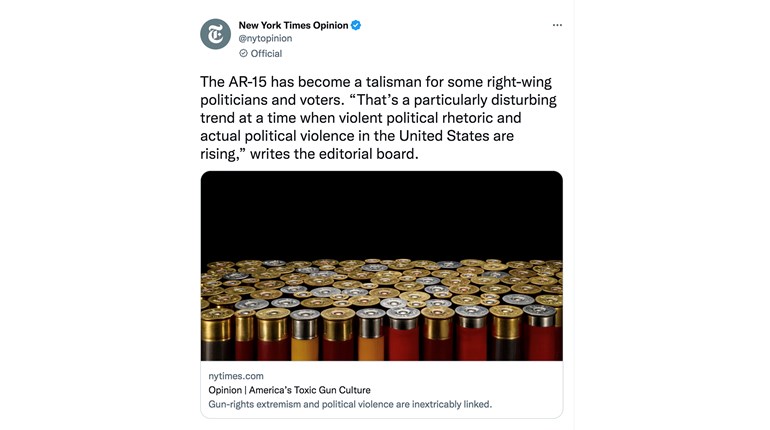
The New York Times is no friend to gun ownership, to say nothing of the Carry Life. Surely this is a no-brainer to anyone that sees the Second Amendment as codifying a natural right—a quick search of A1F’s own pages reveals 150 references to the progressive leviathan. A scan of their titles hints—OK, screams—that few indeed will be flattering.
They repay in kind, naturally, but we would have been doing something else long ago if the mud-slinging caprices of the Grey Lady deflected us. Particularly when it comes to the Second Amendment, her mantra has long been, “All the news that’s fit to print, and most of that which isn’t.”
Now and again, however, the curtain lifts a little on the mindset behind the anti-self-defense machinations grinding away there on 8th Avenue between 40th and 41st. Last Saturday was such an occasion: Daniel J. Levitin penned a column that gives a disheartening look at the impoverished imaginations on which the anti-gun media depends, and that the Times so willingly, so routinely, so ably forwards. We recommend the piece as an exemplar in the art of positively casting a negative proposition, but otherwise—ugh.
A summary is of value: Levitin recounts an episode of surveillance of his home in Los Angeles by a potential intruder, and his reaction to that situation. Interesting and revealing, given that he has “… voted for Democrats in most elections, strongly support gun control and am against the death penalty.”
The self-serving wrong-headedness that follows, however, could be the subject of an entire book. Vague credentials as a gun guy: “… I grew up shooting targets for sport and took part in marksmanship competitions,” are conjoined with iffy acquisitions (even legal in California, we wonder?): “When an older family member decided to get rid of her shotguns and pistol because of arthritis, she offered them to me. So, without fanfare, I became a gun owner.” Consequently, Levitin had arms of some sort within reach when a “sketchy-looking stranger,” started “eyeing the windows,” and perhaps “listening to see whether anyone was home before breaking in.”
We’ll cut to the chase. Levitin, to his credit, determined that he could call law enforcement, exit his home and avoid a confrontation altogether. “There is nothing in my home worth a man’s life,” he wrote. (More on this in a moment.) The self-serving wrong-headedness that follows, however, could be the subject of an entire book.
Bravo, of sorts. We’ve repeatedly said the same in these pages: When offered aggression, your first, best option is to break off. Whether it’s called “getting off the ‘X’” or simply running like hell, it is usually—but not always—the best choice both morally and tactically. But where Levitin’s piece goes confused, dictatorial, condescending and utterly Times-like is in his extrapolations from his lucky one-off. It turns well-crafted words into a formula that is oh-so-casually lethal to individuals, writ small, and to cultures, writ large.
For instance: How about his appalling dismissal of “259 justifiable homicides” in 2012? (Given that it’s Violence Policy Center-sourced, we’re suspicious already, but that is for another day.) But we simply must ask: Does Prof. Levitin hear himself? Those were justifiable homicides: In other words, those people absolutely needed their wherewithal, but Levitin can’t bear not to cast these in doubt by linking them in the same sentence to accidental shootings. Accidents are tragic (and largely preventable), we agree, but a completely different problem. Or look at it this way: Levitin got to make his choice, with the firearms of his choice—which of those 259, we wonder, would he have denied their own? Because that’s what “Democrat” “gun control” does. Those are his words, remember, not ours. And so much for being “against the death penalty,” too, Doc: If you being murdered by someone committing a crime against you isn’t a “death penalty,” what, precisely, is?
Another grotesque insinuation is that retreat—like Levitin was able to employ—is always possible. Disability, physical surroundings, accomplices, and others who might be endangered are just the immediate factors that could make flight impossible—or even more dangerous than staying put. (This, by the way, is the truly heinous wickedness of assaults on “Stand Your Ground” laws. When you’re being assaulted, or even threatened, you’ve already ceded important advantages. Any movement that is blind—backing up, for instance—or that takes your eyes off the threat invites encompassing disaster from multiple causes, and dramatically complicates any defense measure.)
Levitin was successful in playing for time, as well: Law enforcement arrived and handled his intruder. We’re glad, but do you think there are places, occasions and circumstances where this might not work out? Chicago, maybe, or Milwaukee? How about Detroit? Or rural Nebraska, 20 miles from the nearest police station?
That’s another crucial rub from the Carry Life perspective, though one Levitin seems to take ridiculously for granted—that you’ll have time for deliberative niceties. The belief that waiting around for a better set of options—or help—to appear is certainly a progressive touchstone, but one to which the real world is brutally unkind. We can’t help but think of C. S. Lewis: ”We have to take reality as it comes to us. There is no use jabbering about what it ought to be …” Levitin’s reality turned out well, but legitimately scary percentages of others’ realities do not.
Putting the “there is nothing in my home worth a man’s life,” and “talk my way out of it” together, however, is where our blood really runs cold. We’d accept these premises if there was only logical victory or defeat at stake, but at what point does the very fabric of a culture disintegrate into personally lethal consequences? Even in Levitin’s situation, there were huge imponderables. Had the intruder entered the house before he left, disaster could have quite literally evolved, for reasons and to a degree he could not possibly predict. Whether it’s called “getting off the ‘X’” or simply running like hell, it is usually—but not always—the best choice both morally and tactically.
This is the defender’s ugly, even lethal paradox: He or she can be put in a position where winning is the only option, or appeasement of unknown extent and unlikely success (an option particularly dangerous for women, as another of Levitin’s own anecdotes illustrates). The good guy has only brakes and limited time to use them, the aggressor, a throttle, time of his own choosing and a green light. In the wake of his experience, Levitin seems at least to have abandoned the notion “… that in a life-or-death situation, I could reason or talk my way out of it.” Progress of a sort, maybe.
In the end, we can only sigh. Dr. Levitin closes with an even more peculiar mishmash that we hope no Carry Lifer subscribes to. He found himself “off-kilter for days,” but pleased, apparently, that “I will go to bed … as someone who has not killed another human being.” He then asserts: “We all know the statistics that guns don’t make us safer,” but “I’m keeping my guns nearby.” (Note, too, how clearly this implies the good doctor intends to keep making his own choices—why his fellow Dems don’t want the rest of us do the same is another question.) This is the defender’s ugly, even lethal paradox: He or she can be put in a position where winning is the only option, or appeasement of unknown extent and unlikely success.
To the first we say: Well, duh! No remotely healthy person wants to kill another human being, period, as Col. Jeff Cooper observed (here, at roughly 6:35) long ago. But the desire to harm others is quite plainly different than believing that trained, practiced self-defense is a prudent, even humane undertaking—one, in fact, that can make domineering violence entirely impractical. To the second: What gobbledygook! The statistics don’t say that unless you cherry-pick them from organizations with demonstrably rotten agendas and that are insufferably elitist (“guns for me, but not for thee”). And that brings us neatly back to The New York Times.
So don’t buy the damn thing, set a good example for smart folks with stupid gun ideas, and Carry on.
Frank Winn has been studying arms and their relationship to tyranny, meaningful liberty and personal security all his adult life. He has also been a competitive shooter with regional and national titles, and firearms safety/shooting instructor for more than 20 years, though he won’t admit how many more.


































